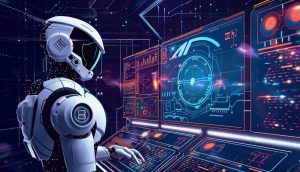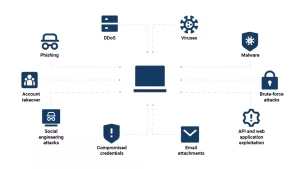AI in Cybersecurity
In today’s increasingly digital world, cyberattacks are evolving at an unprecedented rate. Organizations face threats that are more sophisticated, more persistent, and more damaging than ever before. Enter Artificial Intelligence (AI) — a revolutionary technology that is transforming the future of digital protection. From predictive analytics to real-time threat response, AI in cybersecurity is no longer a luxury, but a necessity.
In this blog, we’ll explore how AI is reshaping the cybersecurity landscape, the tools it powers, and the benefits it brings to businesses and individuals alike.

Understanding AI in Cybersecurity
Artificial Intelligence for Cybersecurity: Smarter, Faster, Safer
Using artificial intelligence for cybersecurity means deploying intelligent systems that mimic human decision-making — only faster and at a greater scale. AI is used in cybersecurity to:
- Predict potential threats using behavioral analytics
- Detect abnormal activities within networks or endpoints
- Automate incident response and containment strategies
- Enhance the performance of existing security tools
One key advantage is that AI can constantly learn and improve. The more data it analyzes, the better it becomes at detecting subtle indicators of compromise (IoCs).
Cybersecurity Tools Powered by AI
Modern cybersecurity solutions are increasingly incorporating AI to enhance protection. Popular AI-powered cybersecurity tools include AI in Cybersecurity:
1. SIEM Security Tools
Security Information and Event Management (SIEM) systems collect and analyze log data from across the IT infrastructure. When integrated with AI, SIEMs can:
- Detect patterns across various systems
- Correlate disparate security events
- Provide real-time alerts with higher accuracy
AI-enhanced SIEM tools reduce false positives and improve detection speed.
2. Endpoint Detection and Response (EDR)
AI-enabled EDR platforms can detect ransomware, keyloggers, and advanced persistent threats (APTs) by analyzing endpoint behaviors.
3. User Behavior Analytics (UBA)
AI models assess normal user behavior and flag any deviations — such as a user downloading large files at odd hours or accessing unauthorized systems.
AI and Cybersecurity: Improving Threat Detection
A major strength of AI and cybersecurity integration is in threat detection. Traditional systems rely on known malware signatures, which makes them ineffective against new, unknown threats.

AI solves this by:
- Analyzing behavior rather than code
- Detecting zero-day attacks through anomaly detection
- Providing early warnings by recognizing subtle indicators
In short, AI doesn’t wait for something to go wrong. It anticipates and acts AI In Cybersecurity.
Data Loss Prevention in Cybersecurity with AI
Data loss prevention (DLP) is critical in protecting sensitive information like customer data, financial records, or intellectual property. AI enhances DLP by:
- Monitoring data movement across the network
- Identifying risky user behavior in real-time
- Blocking suspicious file transfers or email attachments
By continuously analyzing patterns, AI can enforce security policies more efficiently and minimize human error.
Question. Can AI Replace Cybersecurity Experts?
A common question in the industry is: “Will AI replace cybersecurity professionals?” The answer is no. While AI can automate many tasks, it complements rather than replaces human expertise.
AI handles:
- Repetitive tasks
- Large-scale data analysis
- Real-time responses
Humans remain essential for:
- Strategic planning
- Threat intelligence interpretation
- Ethical decision-making
- Creative problem-solving
Together, they form a hybrid defense strategy — where AI enhances speed and scale, while humans bring context and judgment.
Benefits of AI in Cybersecurity
The integration of AI brings several advantages:
Real-Time Detection & Response
AI systems can detect threats in milliseconds and take automatic action, reducing response times drastically.
Reduced False Positives
By learning from past data, AI reduces the number of false alarms, letting analysts focus on real threats.
Cost Efficiency
Automating routine tasks with AI lowers operational costs and allows security teams to do more with fewer resources.
Scalability
AI systems can manage thousands of endpoints and servers simultaneously, making them ideal for large organizations and cloud environments.
Advanced Predictive Capabilities
AI not only detects but also predicts potential breaches based on emerging patterns, helping businesses stay one step ahead.
The Future of AI in Cybersecurity
As technology evolves, so will cyber threats. Future advancements in AI will focus on:
- Adaptive machine learning that evolves with threat landscapes
- Quantum-resilient algorithms to counter next-gen attacks
- Privacy-aware AI systems for regulatory compliance
- AI in IoT security, protecting smart devices and networks
Organizations that invest in AI-driven cybersecurity today will be better prepared to tackle the threats of tomorrow.
Conclusion: Why AI is the Future of Digital Protection
AI is not just a buzzword — it’s a transformational force in cybersecurity. With its ability to detect, analyze, and respond to threats faster than any human team, AI is redefining the future of digital protection AI in Cybersecurity.
While it’s not a complete replacement for human expertise, it enhances capabilities, strengthens defense, and creates a smarter, more resilient digital ecosystem.
If your organization hasn’t yet explored the benefits of AI in cybersecurity, now is the time to start.



